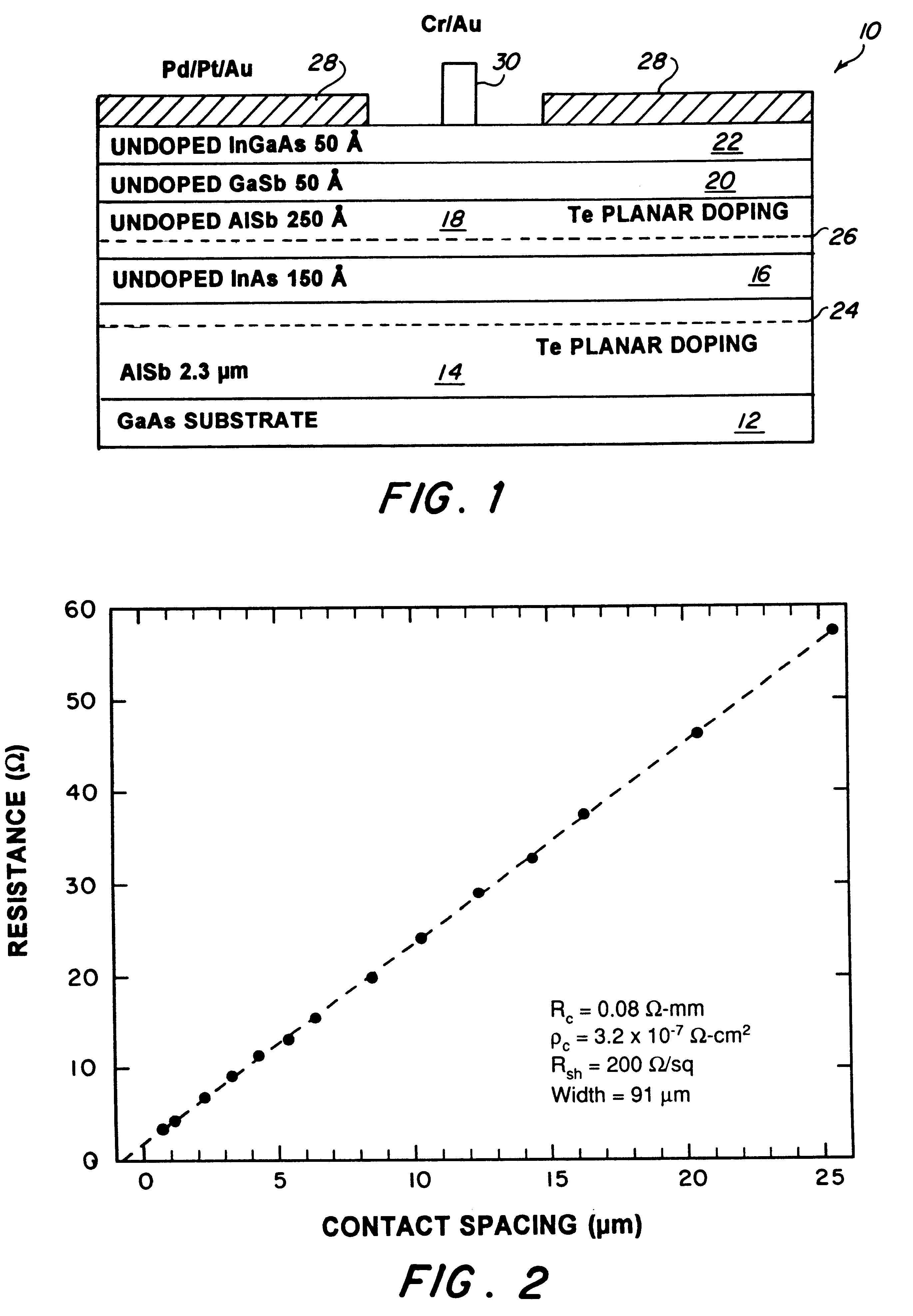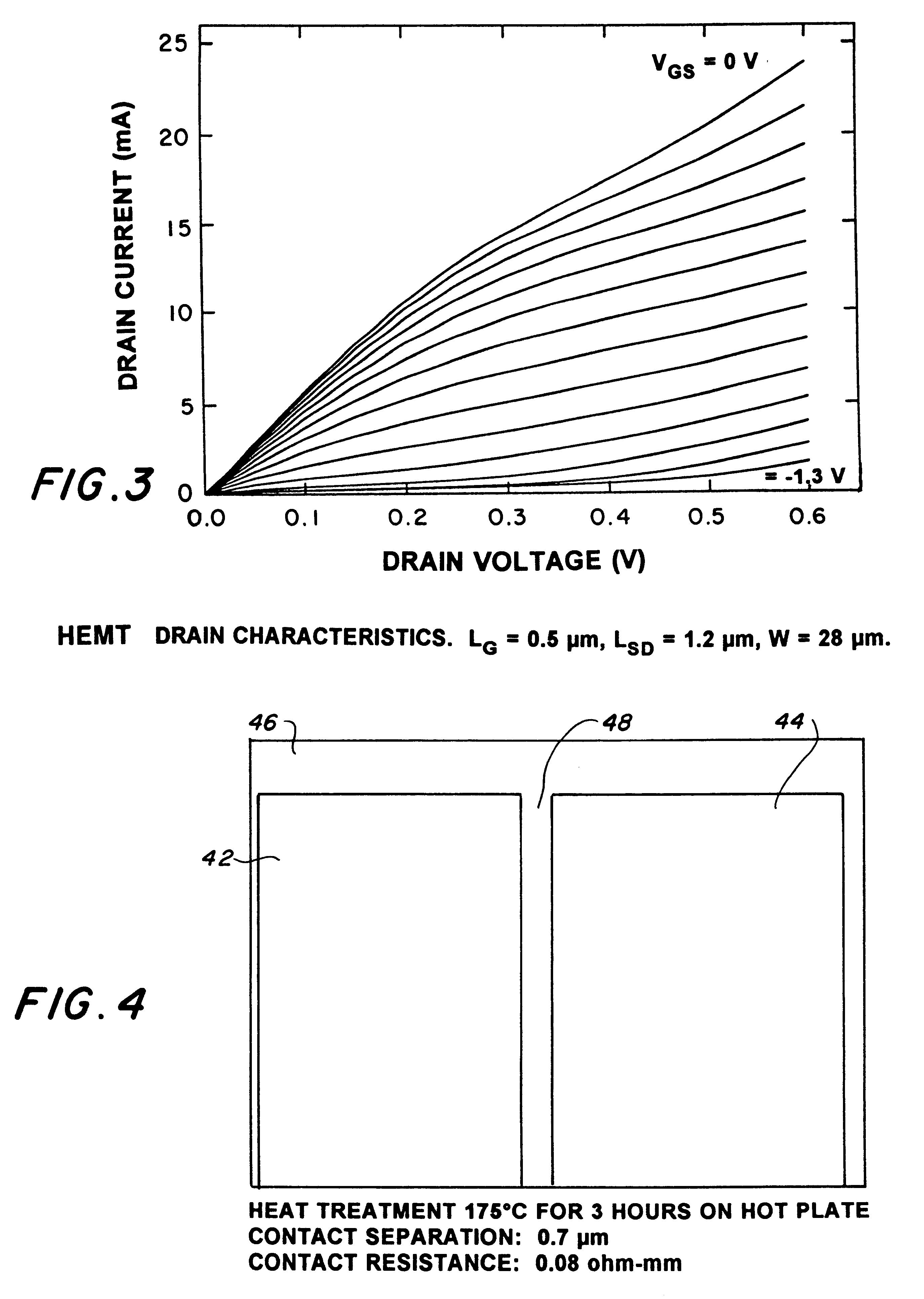Metalization of electronic semiconductor devices
a technology of electronic semiconductors and metalization, applied in semiconductor devices, semiconductor/solid-state device details, electrical devices, etc., can solve the problems of imposing a limit on the minimum hemt source-drain spacing, high contact resistance values, and difficult adhesion of contacts, so as to avoid material deterioration
- Summary
- Abstract
- Description
- Claims
- Application Information
AI Technical Summary
Benefits of technology
Problems solved by technology
Method used
Image
Examples
example 1
This example demonstrates certain advantages realized in conjunction with a AlSb / InAs-based HEMT provided with a contact of Pd / Pt / Au which was heat treated at 175.degree. C. before provision of the gate.
Pursuant to the disclosure herein, layers of AlSb / InAs 10 were grown my molecular beam epitaxy at 510.degree. C. on an updoped (100) GaAs substrate 12 that was about 400 microns thick. The material layer composition and thickness of the HEMT fabricated using the Pd / Pt / Au ohmic contact metalization scheme is shown in FIG. 1. The 2.3 micron updoped AlSb buffer layer 14, disposed on substrate 12, was used to accommodate the 7% lattice mismatch. Undoped InAs channel or quantum well 16, disposed on layer 14, was 150.ANG. thick; another undoped AlSb layer 18, disposed on layer 16, was 250.ANG. thick; undoped GaSb layer 20, disposed on layer 18, was 50.ANG. thick; and undoped InGaAs layer 22, disposed on layer 20 was also 50.ANG. thick. The electron carriers were supplied by the two Te plan...
example 2
This example is similar to Ex. 1 except that the contact was Pd / Au (100.ANG. / 600.ANG.) and the heat treating step was carried out at 175.degree. C. for 5 hours.
Without the platinum diffusion barrier layer, the gold of the Pd / Au contact exhibited significant lateral diffusion into the channel as a result of the heat treatment at 175.degree. C. for 5 hours.
example 3
This example is similar to Ex. 1 except that the heat treatment was carried out in one instance at 175.degree. C. for 5 hours and in another instance it was carried out at 250.degree. C. for 19 hours.
When the heat treatment was carried out at 175.degree. C. for 5 hours, the contact resistance was 0.1 ohm-mm whereas when the heat treatment was at 250.degree. C. for 19 hours, no significant change in the contact resistance or the sheet resistance was observed. On the basis of scanning electron microscopy, no reaction was observed in the region adjacent to the contact as a result of the heat treatment at 250.degree. C. for 19 hours.
PUM
 Login to View More
Login to View More Abstract
Description
Claims
Application Information
 Login to View More
Login to View More - Generate Ideas
- Intellectual Property
- Life Sciences
- Materials
- Tech Scout
- Unparalleled Data Quality
- Higher Quality Content
- 60% Fewer Hallucinations
Browse by: Latest US Patents, China's latest patents, Technical Efficacy Thesaurus, Application Domain, Technology Topic, Popular Technical Reports.
© 2025 PatSnap. All rights reserved.Legal|Privacy policy|Modern Slavery Act Transparency Statement|Sitemap|About US| Contact US: help@patsnap.com



